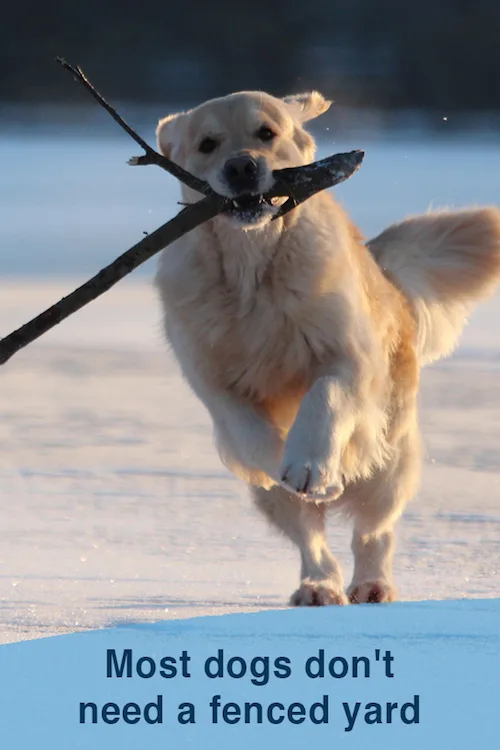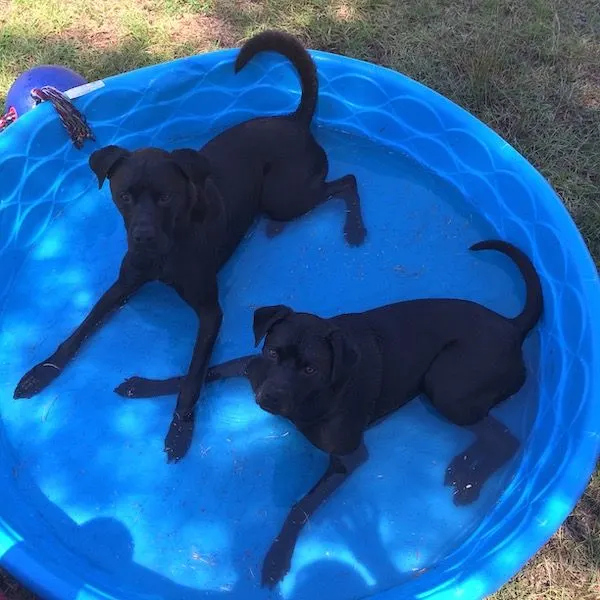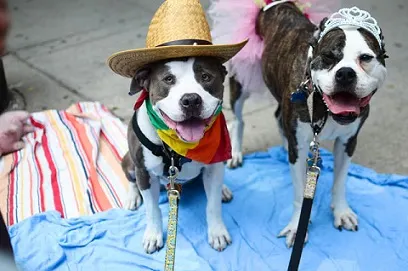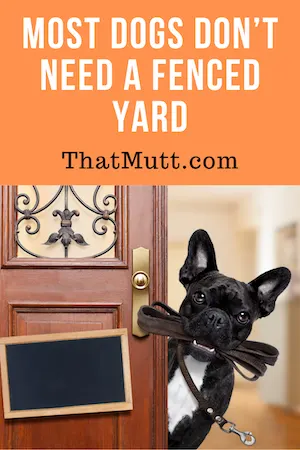A fenced yard is convenient when you own a dog, but most dogs don’t need a fenced yard.
Sometimes people who would like to adopt a dog think they need to have a house with a fenced yard first.
Yes, that would be nice. It’s very convenient for the person as far as letting the dog out. But dogs can get enough exercise in other ways. It’s OK to have a dog if you live in an apartment as long as you have plans to walk your dog every day.
For example, Lindsay’s Lab mix Ace never had a fenced yard and he got a lot of exercise, training, socialization and interaction without a yard.
When he was younger, Lindsay dedicated even more time to exercising him. They often went running for an hour each morning. Even if you are not a runner, there are other ways to provide exercise for your dog.

Reasons why most dogs don’t need a fenced yard
- You can take some dogs to off-leash dog parks or beaches to run around.
- Most dogs don’t use their yards for physical exercise unless someone is interacting with them. Instead, they sniff, pee on things, dig, take naps or patrol the fence.
- You could hire a dog walker to help you out if needed.
- About one-third of people in the United States rent their housing. Meanwhile, half of U.S. households have at least one dog. We can assume plenty of dog owners are renters.
- Sometimes dogs without fenced yards actually get more exercise because their owners are more likely to walk them.
Sometimes dogs without yards are actually more likely to be better socialized and better behaved in public than dogs that have yards. This is because they get to get out more often and visit more places.
Benefits of a fenced yard for dogs
Of course, a fenced yard is nice!
It definitely has a certain convenience factor, especially as far as quick early morning and late night potty breaks are concerned, along with those on crappy weather days.
Also, think about how easy it is to let your pup out into your fenced-in backyard when you are sick.
So, here are several benefits of a fenced yard for dogs:
1. A fenced yard is nice for potty training a puppy
The biggest benefit of a fenced-in yard would be potty training when you decide to bring home puppies or any other adult dog who’s not yet potty trained.
It’s very simple and convenient to just open the back door and let your pup take care of business as opposed to getting fully dressed, wear shoes, and leash your dog.
Don’t get me wrong, all this is doable too. Been there, done that when my two puppies Missy & Buzz moved in with me into a third floor apartment.
We did countless trips up- and downstairs while I potty trained the puppies. However, I’d be lying if I said that a fenced-in backyard wouldn’t have been nice for the duration of our potty training.
2. Socialization
A fenced-in backyard also comes in handy when you’re planning doggy playdates for socialization purposes and to burn off some energy. Unlike at a dog park, you have control over which dogs your dog interacts with in your backyard.
It’s also easier to let your dog wrestle his friends and stretch their legs together outside as opposed to inside your home. There’s less chances of the pups breaking something and drooling all over the place in-between play breaks at the water bowl.
3. Play fetch with your dog in your own yard!
Have you ever tried to play fetch with your dog inside your home? It’s not exactly ideal to say the least unless you’re looking to break a vase or similar fragile furnishing.
That’s why being able to toss the ball or frisbee inside your fenced-in backyard is a winner! There, your pup will be able to stretch her legs and really give her all to get to her favorite fetch toy.
4. Freedom!
Leash training is important and something I practice regularly, but every dog needs a break from it and appreciates just being able to roam around a bit off-leash.
A fenced-in backyard is perfect for that kind of scenario, especially because you won’t have to worry about your pup taking off.
When my puppies and I lived in that third floor apartment, I invested in 30 ft long leashes for the purpose of letting them roam about on our apartment grounds. It worked fairly well, but obviously can’t be compared to the off-leash freedom of a fenced-in yard.
5. Time together in the yard
It’s fun to be able to spend time together with your family, particularly when the weather is nice enough to do so outside in your fenced-in backyard. Picture a BBQ and everyone just hanging out or lounging about on a sun chair.
There’d be something missing if your dog wasn’t around for that, right?
6. Set up a pool!
Dogs who love to splash around in the water will have a blast in their very own doggie pool that you set up in your fenced-in backyard.
You won’t have to worry about potential rope burn or your dog tripping over his own leash or tie-out.

7. Practice agility
If you take your dog to agility classes, he’ll obviously be able to run the obstacle course in a secure area. But what about being able to practice in a similar setting in the privacy of your very own fenced-in backyard? Nothing beats that!
Cons to a fenced yard for dogs
A fenced yard can also come with a few downsides. The biggest issues result from leaving a dog outside in their fenced yard unsupervised for hours on end.
That’s because the dog lacks mental stimulation and ends up getting bored.
Here are a few problems with fences when you have a dog. If you have a fence, you can prevent most of these before they become a problem.
1. Fence fighting
Neighbors who share a fence with dogs on either side often complain about “fence fighting.”
It can start harmlessly with the dogs running along the fence but can ultimately result in frustrated dogs who snarl at each other and jump against the fence in an effort to get at each other.
2. Barking and digging
Dogs can become bored very quickly, especially if they’re young and full of energy. Excessive barking is one outlet for that pent-up energy, and digging is another one.
A backyard dog is the equivalent of a human stuck inside a small room. Can you imagine how incredibly bored you’d become after a few days of this?
3. The dog eats poop (this is called coprophagia)
Gross to us, moderately to highly entertaining to our best friends!
Poop eating can be another result of a bored dog who’s trying to come up with a fun pastime. Or, heck, some dogs just like to eat poop!
The easiest solution for this gross habit is to immediately pick up after your dog and not leave them outside unsupervised in the first place.
4. Escape artists
Some dogs are so bored in their fenced yards that they take matters into their own paws and figure out a way of escaping. Some will jump the fence while others will dig out under it.
I remember going for walks in my old neighborhood with my Boxer mixes Missy and Buzz and frequently having a Husky tag along.
He was one of those backyard dogs who dug out under his fence on a very regular basis. He was harmless and not looking to get into trouble, but imagine what could have happened had he been aggressive towards other dogs or people.
5. Fence maintenance
Another downside of having a fenced-in yard is the fence maintenance. It’ll vary depending on the material and age of the fence.
Wood fences will need boards replaced as they start to rot or break. Owners of dogs who like to dig under their fences regardless of the material will need to refill those holes and come up with solutions to prevent future digging related escapes.
One option might be lining the bottom of the fence with chicken wire, but honestly the easiest way to stop escape artists is to supervise their yard time and to offer mentally stimulating activities such as (backpack) walks, runs, or bike rides.
Some examples of happy apartment dogs
Amy from the blog Two Pitties in the City lives in Chicago with her husband and two adopted pitbulls (pictured below).
Her blog is all about how easy it can be to live in a city and still have bigger dogs, even with no backyard.

She said taking her dogs on so many walks has helped expose her dogs to new situations such as parades and festivals.
This has allowed Amy and her husband to do even more with their dogs, and she said the dogs are well trained and in great shape.
If they had a yard, Amy said she and her husband wouldn’t have the same type of connection they have with their dogs. She said she really enjoys the family time they have together while walking.
We also follow the blog We Live in a Flat, which features Donna the adopted mixed-breed dog who lives in an apartment in Singapore.
Donna loves to be outside for walks, where she gets to meet other dogs as well as sniff every patch of grass possible, her owner said.
The blog is partly about Donna’s owner learning to manage and train her dog to be “a good canine citizen in a high-density living environment.”
One of the great things about dogs is how easily they really do adapt to our lifestyles as long as we provide them with their basic needs.
Do you need a fenced yard to adopt a dog?
Some rescue groups and shelters in the United States require adopters to have fenced yards, but other groups look at dogs and families on a case-by-case basis.
If you’re trying to adopt a dog, keep looking until you find a rescue group that’s down to earth. Shelters are usually more flexible than rescue groups, and I wouldn’t rule out adopting a dog through Craigslist either.
Why do some rescue groups require a fenced yard?
Hi, Barbara here. I write for That Mutt regularly. Last year, I became a foster failure when I ended up adopting my now two-year old dog Wally from a rescue group.
Their requirement for fostering and adopting a dog included having a house with a fenced-in backyard.
They didn’t do a home check in person, but did ask me to send in a video where I essentially took them on a virtual tour of my home, fenced-in yard included.
Luckily I passed their virtual inspection and was approved both for fostering and adopting dogs.
There are several reasons for this fence policy:
- We live in the countryside and roaming dogs are a common sight.
- Rescues want to ensure the dogs are safe and won’t end up getting run over or lost.
- They’re aware that many people aren’t interested in taking their dogs for multiple daily walks.
Requiring a fenced yard is not an ideal policy
That’s because it disqualifies many great potential adopters from bringing a rescue dog home with them.
“Oh I’m sorry, you don’t have a fenced-in yard? Move right along.” That judgement call is both frustrating and unfair.
If a dog ends up stuck in a fenced-in yard all day long and frequently escapes, what’s the point of having a fenced-in yard, and is that dog truly safe?
If rescues were more flexible with their fence policy, they’d be able to adopt out more dogs than they currently do.
They’d also stop contributing to the creation of bored yard dogs.
Obviously they’ll still want to make sure that an adopter and the adopted dog are a good match, but there are other criteria that should matter besides a fence such as:
- Does the potential adopter have references?
- Do they make a good first impression?
- How does the dog react to them?
- Are they interested in taking the dog for a walk?
- Do they seem physically fit if planning on adopting a high energy dog?
- Do they have a support system in place such as a dog walker, neighbor or reliable family member if they work long hours?
To me, it seems like this check-list would still give rescue groups a good idea of who they’re dealing with and whether or not the potential adopter would be a good fit.

What kind of fence is best for a dog?
As far as which kind of fence works best for a dog, it really depends on the dog’s size and their owner’s budget and location as different material fences come with varying costs and maintenance needs.
Certain neighborhoods with HOAs will also be able to dictate which type of fence can be installed. The different fence types are, from least to most expensive:
- Chain link
- Wooden
- Vinyl
- Metal/Aluminum
Vinyl and metal fences are more expensive upfront but require almost no maintenance. They’re also more visually appealing than chain link and wooden fences and are usually found in more upscale neighborhoods.
Vinyl and wooden fences offer the most privacy and can be beneficial for dogs who are easily triggered by anything that moves on the other side of their fence, including mail delivery services, kids on bikes, joggers, and other dogs.
Chain link fences are the cheapest, but also the least effective in securing a larger dog, especially if the dog is bored and prone to escaping. As a matter of fact, dogs who are determined can easily climb that type of fence!
Alternatives to a fence for your dog
If a physical fence isn’t an option, there are a few alternatives. These may work if the fence budget is extremely limited or if HOAs prohibit putting up an actual fence.
1. Electronic fence or Invisible Fence
An underground electronic fence such as the Invisible Fence brand is designed to keep a dog from crossing the boundary of their yard without a physical fence.
However, dogs first need to be trained to respect the Invisible Fence, of course. This in itself is the largest downside of an electronic fence because you can’t just have it installed and expect your dog to know what to do.
Other cons of an Invisible Fence:
- It’s fairly expensive and can easily run upwards of $1,000.
- Requires your dog to wear a special battery operated collar that needs to be charged.
- It doesn’t keep other animals or people out of your yard.
- It doesn’t deter a dog from exiting the yard if their prey drive is extremely strong. Those dogs will accept the momentary discomfort of being shocked.
See our posts on electronic fences for dogs:
2. Use a tie-out for your dog
Tie-outs are in-ground anchors or stakes that have a long cable or leash tied to them. The cable or leash are then attached to the dog’s collar or harness to keep him confined within the diameter of the tie-out.
They’re an inexpensive option of keeping a dog secured outside and can be taken along when you’re moving or camping.
However, a dog’s who’s attached to a tie-out shouldn’t be left unsupervised. If he starts getting bored due to a lack of mental stimulation, he might very well start chewing on the cable or leash and break free in no time.
3. Large Ex-pen for puppies
Large ex-pens are a great way of keeping puppies confined to a certain area, both inside and outside. They’re sturdy and come in different sizes, so it’s highly unlikely that the puppies would be able to climb it or knock it over.
That being said, the little ones should still be supervised when they’re hanging out in an ex-pen.
It’s a good idea to use an ex-pen if you’re busy around the house but are still able to check in on the puppies, for example when you’re cooking dinner or doing laundry.
OK, enough from us! Now we’d love to hear from you in the comments below.
Do you believe dogs need a fenced yard?
Let us know in the comments!

Henry
Sunday 17th of July 2022
Just bought the place. Already have a perfect rescue dog. No fence came with the property but I will eventually put one in. In the meantime, I wanted to help aliviate the pressure of stray dogs on the system and eventually they find a great home. I walk my dog 10 - 15 miles a week. Regular structured potty breaks between. I take her to the various dog beaches and dog parks on a regular basis. She eats top quality food. She lives in dog paradise with deer, squirrels (her favorite) livestock (also her favorite) and even other predators that could easily take her, though, other than a bobcat, I haven't seen any yet. I'm always present to supervise. If you ever saw her you would only see a happy, healthy, well adjusted dog. Fences are great but absolutely not necessary. I've had both situations. What's necessary is an understanding and commitment to the animal. Even if I had a fence out here there's no stopping a cougar or really angry bear or a diamondback rattlesnake. Fences are false security in many cases. If I had a fence I still wouldn't leave her outside alone. It's not about the fence. It's about the person committed to the animal. Responsible adults know what to do.
N
Tuesday 15th of March 2022
A dog is better off in most homes than a shelter. However some shelters have actual wait lists and you saw what happened during Covid. Nothing wrong with the shelter trying to find the best home in that case. I think many people leave dogs alone for too long and tell themselves it’s ok. The dog will survive it but does NOT like it. Another dog helps but they miss mom and dad same as actual kids would. Everything isn’t about human convenience. I don’t think life should center around a dog but nor should it center around a human. My first concern would be who’s with the dog and how long. Sure there’s no guarantee of interaction but if you’re not there you cannot interact. With exercise anyone can lie so all you can do is guess by how fit active the person is. Half the people on my block say they walk their dog just to go potty unless the weather is great. That’s fine but often leads to restless dogs depending on the breed. I totally disagree about the yard but want to say if a dog never had one and then you give one they may not take to it. No dog wants to be alone in a yard for more than 10/15 min unless a puppy. But I’ve had running (zooming) esp late night. Dogs love sitting right in the sun outside. And just for pooping in rainstorms it’s worth it imo. Most shelters are full of older dogs special needs dogs or dogs who just aren’t adopted out. Not sure first preference on puppies should be given to someone in a studio apartment. Of course there are amazing studio Apt owners esp now that many people can be home. But most dogs are much happier w a yard. Sometimes what it takes people to move are kids and dogs!
Meg
Sunday 1st of March 2020
I have to have a fenced in your for my Malinois. I agree with the other poster who said it is to keep the dog in and other dogs/wildlife out. I have a wooded wetland with a creek as my neighbor behind me and the deer/coyotes/feral cats are everywhere! We also had a skunk "issue" a few years ago. I love my 6ft vinyl privacy fence. It is perfect for frisbee a match and made potty training a breeze.
Vicky Monogue
Sunday 8th of November 2020
Hi ,
I have been reading all the comments. Here may be another thing to think of. I volunteer for a rescue, have four cats, and after two years we just adopted Colt from the rescue. My poor pup went through hell at 6 weeks he came down with parvo, as did some of his litter mates. He had to be separated, was then admitted to an emergency vet clinic for one solid week. Isolated for that week, then had to be treated for cocsidia . All of this put him behind in his puppy shots. There for I could only give him exercise in my yard as he healed. Of course ASAP he STARTED. His first shots, then he had to be neutered, so there went more time as well as letting his hernia heal too. So with those reasons it would have been great to exercise with him while he had to be protected from things he could have picked up during a walk. I would love to take him to a dog park but he has more shots coming up first...now he has grown ...a lot. You sure can’t play fetch with him on a leash or tie out! His mom is black lab, I’m told def has some poodle. But who knows what dad is! He goes to daycare x2 weekly for socialization, and puppy classes are done this week with other classes I will sign him up for. So we do want a fence but we will also be going for walks. The other thing living in wisconsin winter can be yuck! So w3 can still play in the snow , and go for walks too!
momkastner
Sunday 1st of March 2020
So an issue rarely covered by any training blogs. "Farm/Country" dogs. I live in the middle of a 100 acre woods. I want a dog who's job is to keep the "critters" out of the yard-deer, coyotes, raccoons, etc. Of course, the dog would have indoor access, especially during the cold weather months. But ideally, he would be outside 24/7 as many, if not most critters come during the overnight hours. So how does one teach the dog to stay "in the yard"? My last outdoor dog had the bad habit of going to visit our other farm neighbors - no one really wants someone else's dog at their home. They learned who she belonged to & would call for us to pick her up. Fencing the yard or invisible fence isn't a realistic option. Suggestions?
Lindsay Stordahl
Sunday 1st of March 2020
I have a post on this topic written by That Mutt's writer Julia. Hopefully it will help you brainstorm: https://www.thatmutt.com/2019/08/26/how-to-train-a-dog-to-stay-on-your-property/
Linda
Sunday 1st of March 2020
Fences are as much to keep other dogs OUT as our dogs IN. I'm in Houston and the number of free-roaming, untrained, un-fixed and unvaccinated dogs is horrifying. They frequently roam in packs, attacking others, and causing massive damage. Give me a fenced yard every time.